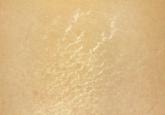Cosmetic Dermatology

Interventions for the Treatment of Stretch Marks: A Systematic Review
Stretch marks are a common disfiguring skin condition that can have a deep psychological impact on affected patients. Although there are a variety...
Joy D. Wisniewski, MD; Dana L. Ellis, MD; Mary P. Lupo, MD
From the Department of Dermatology, Tulane University Hospital, New Orleans, Louisiana.
Drs. Wisniewski and Ellis report no conflict of interest. Dr. Lupo reports the following relationships: advisory board member, clinical investigator, speaker, and trainer for Allergan, Inc; clinical investigator for Bayer Health Care Pharmaceuticals; speaker for BTL Industries Ltd; speaker for Cutera, Inc; researcher for Dr. Holmquist Healthcare, LLC; advisory board member and speaker for Galderma Laboratories, LP; clinical investigator for Kythera Biopharmaceuticals, Inc; advisory board member for L’Oréal; speaker for Lumenis; clinical investigator for Rock Creek Pharmaceuticals Inc; founding investor and stockholder for Strathspey Crown/Alphaeon Corporation; consultant and stockholder for Theraplex; advisory board member and stockholder for TopMD, Inc; and advisory board member, speaker, and trainer for Valeant Pharmaceuticals International, Inc.
Correspondence: Dana L. Ellis, MD, 1430 Tulane Ave #8036, New Orleans, LA 70112 (dana11ellis@gmail.com).

Cosmetic patients are looking for a more youthful appearance without spending a lot of money, feeling any pain, or experiencing any postprocedure downtime. New cosmeceutical therapies can be used adjuvant to chemical peels, lasers, and injectables, making antiaging regimens less painful and requiring less postprocedural healing time. Adjunctive agents can be used to enhance chemical peels and decrease postinflammatory hyperpigmentation (PIH). Topical retinoids used prior to ablative laser treatments can aid in faster postprocedure healing and reepithelialization. Cosmeceuticals that contain both antioxidants and anti-inflammatories can help reduce postprocedure inflammation. Acetyl hexapeptide-3 is an effective topical agent for decreasing wrinkles and can be used as an adjunct to intramuscular botulinum neurotoxin, which may reduce the number of injections needed. Topical hyaluronic acid also would help patients who are averse to needles or are just starting to get wrinkles and are looking for noninvasive therapy. This article reviews combinations of cosmeceuticals with cosmetic procedures that dermatologists may want to consider discussing with their cosmetic patients.
Practice Points
Today’s cosmetic patient wants to look more youthful every day without spending a lot of money, feeling any pain, or having any postprocedure downtime. With continued technological improvements, dermatologists have been able to provide our patients with the more youthful appearance they desire; however, many of these procedures still are costly, painful, and may require some downtime. New cosmeceutical therapies can be used as adjuncts to these procedures, making antiaging regimens less painful for patients and requiring less postprocedure healing time. In this article, the use of cosmeceuticals in conjunction with chemical peels, lasers, and injectables will be discussed.
Chemical Peels
Chemical peels are used to create an injury of specific skin depth with a goal of stimulating new skin growth and improving surface texture and appearance. They generally are classified as superficial, medium, or deep according to the depth of action. Currently available agents for superficial chemical peels include α-hydroxy acids (AHAs)(eg, glycolic acid [GA]) and β-hydroxy acids (BHAs)(eg, salicylic acid). β-Lipohydroxy acid (up to 10%), a derivative of salicylic acid, is widely used in Europe. Trichloroacetic acid (TCA) can be used for superficial peels (10%–20%) and for medium-depth peels (35%). Combination peels such as Monheit combination (Jessner solution plus TCA), Brody combination (solid CO2 plus TCA), Coleman combination (GA 70% plus TCA), and Jessner solution with GA can be used as medium-depth peels. Deep peels typically are performed with phenol-based solutions, including the Baker-Gordon phenol peel and the Hetter peel (phenol or croton oil peel).
Specific agents for chemical peels should be selected based on the disorder being treated and should be administered using an appropriate peel depth determined by the histologic level or severity of skin pathology to maximize treatment success.1 However, other considerations, such as skin characteristics, area of skin to be treated, safety concerns, healing time, and patient adherence also should be taken into account to achieve the best overall results. Although many of the deeper peels recently have been replaced by laser-based ablative treatments, superficial to medium-depth peels still are commonly used in the treatment of fine lines, uneven texture, and dyspigmentation.2
Superficial peels are reasonably safe and well tolerated, usually with only mild discomfort (eg, transient burning, irritation, erythema). Scarring, postinflammatory hyperpigmentation (PIH), and infection are rare with superficial peels.1 Postinflammatory hyperpigmentation can be exacerbated by sun exposure, making it important for patients to be educated about sun protection and closely monitored during the recovery phase. In medium and deep peels, lines of demarcation related to the administration technique can occur. Feathering the chemical peel solution at junctions with nonpeeled skin can help to avoid this effect.1 Side effects associated with deeper chemical peels can include pigmentary changes, infections, allergic reactions, improper healing, hypersensitivity, and underlying disease exacerbation. The best way to prevent complications is to identify patients who are at risk and maintain an appropriate peel depth that balances efficacy with known adverse events.1
Many adjunctive agents (eg, AHAs, BHAs, retinoids, skin-bleaching preparations) can be used to enhance chemical peels and decrease the incidence of PIH. α-Hydroxy acids and BHAs can be beneficial when applied prior to chemical peels. Moisturizers containing AHAs and BHAs can be used for 2 to 3 weeks before superficial or medium-depth chemical peels.2 These agents cause thinning of the stratum corneum, thereby creating a more uniform cutaneous surface and allowing for deeper penetration of the chemical peeling agent. Retinoids also are superior prepeeling agents; however, retinoids also can increase the likelihood of irritation, which can be minimized by discontinuing retinoids for 1 week following chemical peels.2 A combination of chemical peels and topical bleaching agents has been shown to be effective in treating hyperpigmentation. The chemical peel causes superficial exfoliation, which allows the lightening agent to penetrate more deeply.2
Hydroquinone (HQ) is the gold standard for improvement of existing pigmentation.3 It is one of the most effective inhibitors of melanogenesis both in vitro and in vivo and is widely used for the treatment of melanosis and other hyperpigmentary disorders. It is widely accepted that the depigmentation activity of HQ may partly be related to its ability to act as an alternate substrate of tyrosinase, thereby competing for tyrosine oxidation in active melanocytes.3 Using HQ at a 4% concentration and combining it with retinoids is quite efficacious.2 Other commonly used depigmenting agents include kojic acid, ascorbic acid (vitamin C), and niacinamide, which often can be used as adjuncts with or maintenance therapy after HQ treatment.2,3
The risk for PIH is imminent for chemical peels and cosmetic laser treatments; therefore, it is crucial to educate patients about the importance of daily and aggressive sun protection. There are several methods of reducing or eliminating postprocedure melanin formation, such as inhibiting tyrosinase synthesis, using complex copper to inhibit tyrosinase function, eliminating oxidation reactions that lead to polymer formation, slowing down the transfer of melanosomes to keratinocytes, or acting upstream on the hormone that stimulates melanogenesis.3 Most of the depigmenting agents presently on the market act by inhibiting tyrosinase via one of these mechanisms.

Stretch marks are a common disfiguring skin condition that can have a deep psychological impact on affected patients. Although there are a variety...

Rosacea is a chronic inflammatory disease that predominantly affects facial skin in light-skinned individuals and can be divided into 4 subtypes....

Dr. Navid Ezra discusses best practices in the use of pulsed dye lasers (PDLs) for treatment of vascular lesions.
